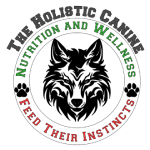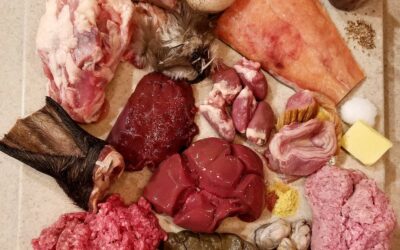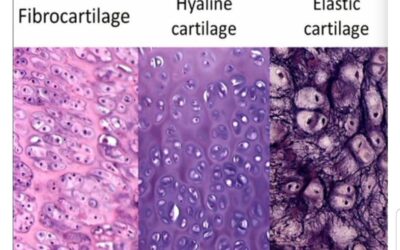Choosing your method of DIY raw feeding
There are several models and methods of feeding your dog a raw diet. However, following one specific model can be too limiting making if difficult to meet nutritional requirements without having to resort to heavy supplementation. Becoming familiar with the various raw models is an important step for knowing how best to provide for your dog’s nutrient needs.
How Should You Feed Your Dog? Carnivore vs. Omnivore
There are several models and methods of DIY raw feeding that can be followed. And behind those models and methods lie some pretty convincing philosophies and interpretations of what science has shown us about our canine companions. There are two extreme views that exist; and from my own research and education, both extremes have several shady areas that do not stand as factual. Before you can decide how and what to feed your dog, you must understand what dogs are designed to consume. Let’s take a look at these two extreme views.
Pure Carnivore
One philosophy that is hugely popular in the UK and Australia and has spread throughout Europe and to the USA is the strict carnivore model. This philosophy interprets a dog’s anatomy as purely carnivore and sees the physiology as strictly carnivore as well. While you cannot ignore the fact that a dog’s anatomy is undeniably carnivore, it isn’t quite so cut-and-dry when we examine the physiology.
Many adherents to the strict carnivore model teach that dogs do not produce salivary amylase; therefore, they conclude, dogs are strict carnivores as only omnivores produce salivary amylase. Now, in their defense, I am only part of a minute handful of people who are actually aware of the study that detected tiny amounts of salivary amylase in Beagles[1]. Herbivores, you may be surprised to learn, do not produce salivary amylase either, and yet sensitive tests have also detected it in lambs. So take both those findings for what their worth. So, yes, this is true in a sense. However, their teaching starts to go south when proponents of this view start to make claims that are clearly not proven.
It is taught that a dog’s pancreas is “strained” when carbohydrates of any kind are ingested as this requires that the pancreas must produce amylase enzyme. Carbohydrates are defined as vegetables, fruits, starches, sugars, grains, and legumes. While any organ can be strained from overwork, the function of the pancreas is to produce hormones and enzymes; therefore, normal function would not “strain” an organ. However, just like in humans, when the organ is abused (key word here) by excessive consumption of inappropriate foods, then yes, the organ will be overburdened and damage often occurs. Both the NRC and AAFCO do not list carbohydrate requirements because both know that dogs have absolutely no requirement for carbohydrates. So are the carnivore purists correct?
If this were a fact, then the high-carbohydrate commercial diets over the past one hundred years would have mass murdered millions of dogs. And since this wasn’t or isn’t the case, that in itself is proof that their claim in not entirely true. However, dogs have developed numerous health conditions, chronic disease, joint deterioration, cancer, and increased mortality at an alarming rate. So maybe there is some credibility to their claim? The answer is yes. Let’s look at the other extreme view to see why.
Omnivore
There is a large group of raw feeders and proponents of homemade cooked dog food that claim dogs are omnivores. This is the view held by the major commercial dog food manufacturers and even many veterinarians. However, the dog food companies have an agenda: dog food sales. When an agenda enters the equation, you know darn well that agendas and philosophies start to be touted as fact.
The omnivore theorists point to the fact that dogs do in fact produce pancreatic amylase. Recently, many have groped at the exhaustingly misinterpreted AMY2B gene in domestic dogs that codes for amylase enzyme. It is taught that because dogs have anywhere from four to thirty copies of the AMY2B gene, unlike their close cousin the wolf who has a mere two copies (dog DNA is only 0.2% different from the wolf), dogs, therefore, have evolved to life with humans and have turned into omnivores. Sounds factual since dogs can in fact eat high carbohydrate diets without immediate consequence (other than obesity) and dying immediately. Yet, how can we explain the rapid rise in chronic disease that just so happens to parallel human disease and the increased mortality rate in the modern canine?
The answer lies in the correct understanding of epigenetic gene expression and adaption. Dogs have simply adapted through epigenetic gene expression to survive with humans. This adaptation potential is within the DNA of ALL canines, including wolves. (Adaptation potential is actually encoded in every living being.) The exposure to high carbohydrate diets with humans turned “ON” the gene expression within dogs that codes for amylase enzyme. Each consecutive generation of domestic dog, therefore, passed the code onto their offspring until a select few breeds developed higher numbers of the gene than others. Epigenetic gene expression is common knowledge within the scientific community, but not among lay people who misinterpet scientific papers and articles (not to mention read with a biased eye). Gene expression is directly affected by diet and environment. Dogs simply adapted to life with humans. Understand that adaptation is a survival mechanism that in no way equates to thriving.
So, what was it exactly that drove the raw food movement initially? Sadly, canine disease and the increasing mortality rate. So how did this happen if dogs evolved into omnivores? Let’s be real here. Dogs are clearly anatomically NOT omnivores. This simply cannot be denied. Their teeth, jaw and jaw movement, neck, body structure, and digestive tract are in no wise omnivorous. If adaptation changed canines into omnivores, then their anatomy would have followed suit. And clearly, that is not the case. Physical (anatomical) changes are absolutely essential if something as serious as food sources has changed. One has only to look at Charles Darwin’s Galapagos Island finch study [2, 3]. The finch has coded within its DNA a genome that codes for beak shape. The finch has the adaptation ability to change beak shape entirely as a direct result of available food source and environmental conditions. The gene expression is turned “on” depend upon outside conditions. And conversely, the gene expression can be turned “off” and the beak returns to the original shape. This is observed in the offspring of the following generations as gene code expression is passed on to future generations.
Have dogs changed anatomically? Not in the least. While selective breeding plays a role in appearance and size, dogs are still structurally carnivores. They have simply adapted and increased a mere ONE gene code as a direct result of the diet offered to them by their human companions, nothing further. So what is the verdict?
Dogs are neither obligate carnivores nor are they omnivores.
Dogs are FACULTATIVE CARNIVORES. Period.
What does this mean? Biology states that facultative carnivores are “able to live under a range of external conditions” for survival purposes in the absence of their species-appropriate diet and environmental conditions.
How should you feed your dog? Like the facultative carnivore that they are!
[1] https://bmcvetres.biomedcentral.com/…/10.…/s12917-017-1191-4
[2] https://explorable.com/darwins-finches
[3] https://news.nationalgeographic.com/news/2015/02/150211-evolution-darwin-finches-beaks-genome-science/
Should You Follow a Raw Model or Ratio?
There are several models for canine raw feeding as well as helpful ratios that can be used as guidelines for creating balanced meals. The two most popular models are Prey Model Raw (PMR) and BARF (biologically appropriate raw food). The most popular ratio guideline is 80/10/10 or 80/10/5/5 which pertains to the ratio of flesh to organ and bone in whole prey. From these original models and ratios, raw feeding has evolved. To learn more about models and ratios, read my article “Simplifying the Raw Food Models.”
https://theholisticcanine17.com/…/simplifying-the-raw-food…/
Many people tend to follow trends, the advice of friends or people close to them, or stick with what is popular. But when it comes to feeding your dog, trends, well-meaning advice, and popularity is not necessarily on the table as a good option. Nutrition is serious business. Knowing and understanding how to create meals using a model or ratio as your guide is essential to the health and wellbeing of your dog that may just have a serious impact on longevity.
While some dogs do exceptionally well on a BARF model diet, some just plain don’t. Simple as that. And where many so-called canine “nutritionists” make extremist statements such as “PMR is an unbalanced diet plan,” you absolutely cannot deny that there are generations of dogs doing exceptionally well on PMR and living to incredible ages. Also, simple as that. And, have you noticed that some dogs live to an impressively old age on kibble? As hard as that may be to swallow, it is true. Sadly, others do not and their lives are one suffering experience after another. The truth is, dogs are facultative.
Dogs are undoubtedly (and impressively) nutritionally-versatile creatures. But it is for this reason that dogs are among the most nutritionally abused animals on the planet (next to humans). The most critical question to ask is: just because dogs can be nutritionally abused without immediate consequence, does this mean they should be? I pray your answer is wholeheartedly NO.
Let me go back to the question I have posed in the section title: “Should you follow a raw food model or ratio?” What is your answer? Is there an answer? Being that my expertise is orthomolecular nutrition science coupled with my doctoral research on species-appropriate diets in humans and animals, I believe there is a definitive answer.
SPECIES-APPROPRIATE. End of story.
Species-appropriate Raw Diet
I won’t lie, I used to be a BARF model purist. As a human nutritionist, I see the value in plant-based diets (this does not mean vegetarian) and have witnessed health return to people of all ages and conditions, including stage 4 cancer. Naturally, I see incredible value in organically grown produce. How can we not share that value with our canine companions? But as time went by and my experience, research, and education expanded, I could no longer deny that PMR feeders were experiencing exceptional results and producing offspring that lived to almost unbelievable ages. Just take a look at Thomas Sandberg’s results in his own dogs and in his Long Living Pets Research Project (which, btw, my six dogs are a part of). Thomas, like myself, is a board certified holistic health practitioner and practicing naturopath…and also a PMR feeder and teacher. And he is reversing cancer! Results are results, they can’t be denied.
So what am I saying? No, I did not cross the street to the PMR purists, but nor do I adhere to BARF. I have realized that nutrition is based on each individual dog and blending the two models has produced incredible results…including cancer therapy (more on that in the future as I have an on-going study). My stance is strictly species-appropriate nutrition plans.
After reviewing the many research results on zero and low-carbohydrate diets in endurance dogs that the NRC reported on in their work “Nutrition Requirements of Dogs and Cats,” I realized that carbohydrates really do not have much value. Nor do they for humans. Since I am known as the “weight loss guru” in my human nutrition practice, I realized that I should take that same strategy to the dogs. What strategy? Low-carb nutrition plans. Since dogs have no requirement for carbohydrates, as is stated by the NRC and AAFCO, why would we need to add them when the studies showed that the zero and lowest carb diets produced the better athletic performance in the test dogs? Unlike protein and fats that have multiple vital purposes and functions, carbohydrates have but one…energy, something that fat supplies as well as protein (via gluconeogenesis in carnivores). Nothing else, no other need, and non-vital.
What do facultative carnivores eat? Prey. And when prey is in short supply, their incredible facultative adaptability allows them to survive (intended for short periods, mind you) on scavenged food, human garbage, berries and other fruit, grasses, and not much else. We need to focus on species-appropriate foods that are easy to digest, offer the highest nutrient absorption rate, and the absence of anti-nutrients that prevent nutrient absorption.
The focus of your dog’s nutrition should be species appropriate foods. Not a model, not a ratio, but foods that are best for dogs. See my article entitled “The Importance of Species-appropriate Foods for the Cultivation of Optimal Health.”
https://theholisticcanine17.com/…/the-importance-of-specie…/
Focus on your dog’s NRC nutrient requirements (which does not include carbohydrates) and create meals around those needs. Protein and fat from fresh raw mammal and poultry flesh, organs and offal, and raw meaty bones (and don’t forget fish and crustaceans!) should be your main focus. And if your dog can adequately digest, without ANY difficulties, some vegetables, seaweeds, and ground seeds in small percentages, these can offer additional value. Note, I emphasize SMALL. Fruit can be an option, but is not always appropriate. I have had enough experience to know that fruit tends to be the main cause of itching, ear conditions, and yeast overgrowth, among other issues. Fruit, like in human nutrition, needs to be offered and consumed apart from mealtime. Again, fruit should not be fed in meals, but as treats.
Never force your dog to eat vegetables and fruits. These are optional and often your dog knows that he or she cannot digest them and/or they are making them feel yucky. Be observant and examine stools. Stools are your window into the internal workings of your dog’s digestion. My six dogs do eat vegetables on occasion and once in awhile they will get berries for treats. But all in all, they don’t want them. Your dog can help you to learn quite a bit about canine nutrition. Pay attention! And when in doubt, ask a professional.
©2019 Kimberly Lloyd, PhD, BCHHP, Cert Raw Dog Food Nutritionist



